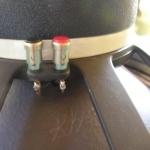This is what Zilch on the forum measured for the tuning frequencies:
http://www.audioheritage.org/vbullet...l=1#post216106
So I'm running the E145 with one port closed in the 4507, so tuned to about 34Hz.I've measured and documented 4507 tuning several times in these forums.
Here's my recollection, but y'all can look it up to be sure:
4 ports open = 40 Hz, the stock tuning for 2225H, E140, and similar.
One port closed = 34 Hz, stock 4430 tuning.
Two ports closed = 28 Hz, extended bass or sub duty, which is how I run them mostly....




 Reply With Quote
Reply With Quote





